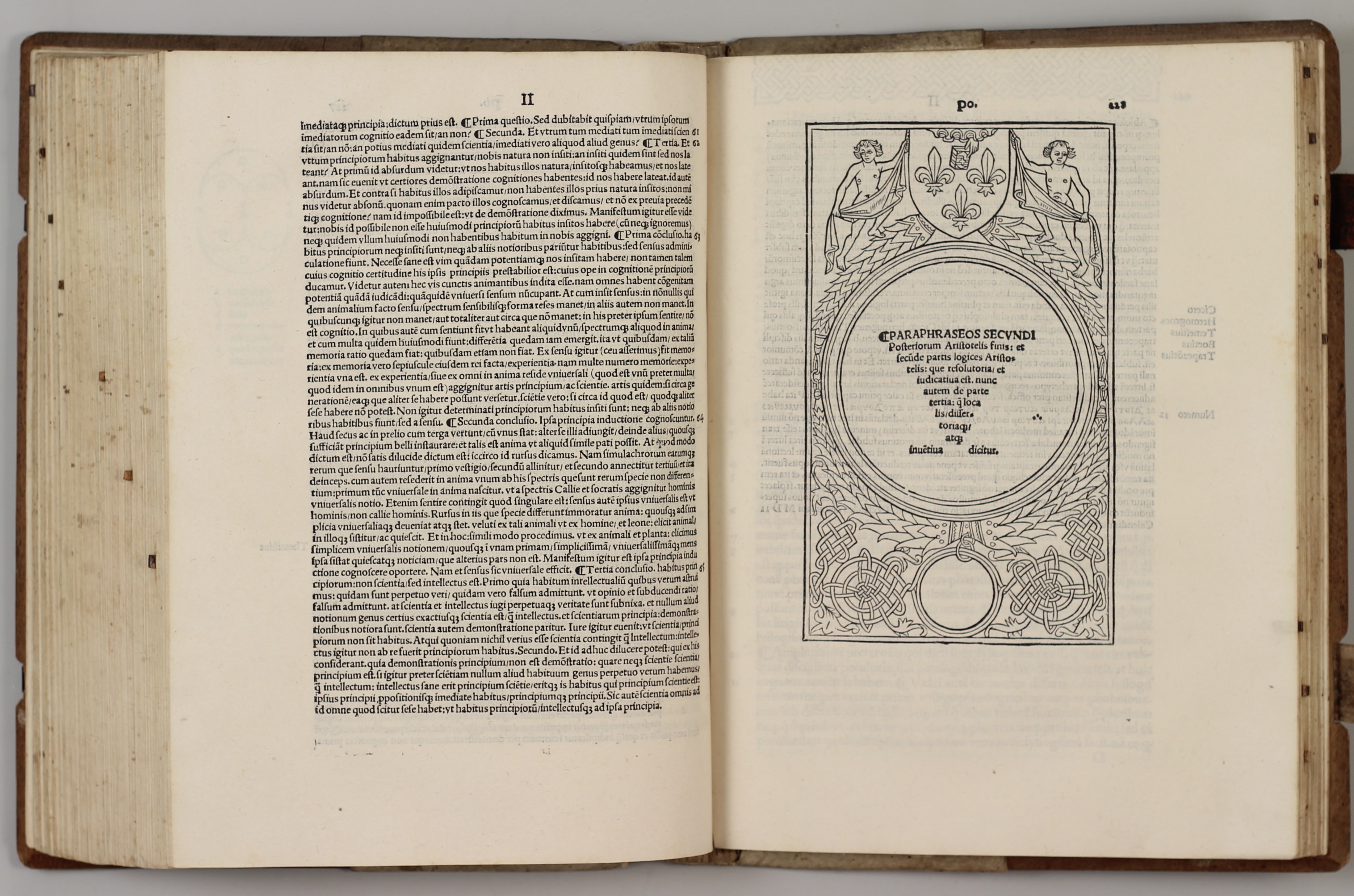Aristotle / Faber Stapulensis [sold]
Libri logicorum. — Paris 1501/1503
Libri logicorum. Ad archetypos recogniti, cum novis ad litteram commentarijs … — [Colophon on k6:] … ex Volgangiana [sic] officina anno Christi … M.CCCCCI … Octobris XXVI; [Colophon on P8:] … ex officina Volphangiana. Impensis Volphangi Hopilii et Henrici Stephani, 1503 xvij octobris. Parisiis.
[Paris, W. Hopyl, 1501 [Logica vetus] / W. Hopyl & H. Stephanus, Octobre 1503 [Logica nova]]
First edition of Lefèvre d’Étaples‘ commentary
Folio (283 x 208 mm). a-i8 k6 l-z8 A-E8 F6 G-P8: (1), 300 leaves. First use of Estienne’s first title-border on F6, incorporating arms of the University of Paris.
Provenance: „Sum Ioannis …“ on title-page, can’t read the rest. A few contemporary marginal annotations. A second name on title erased, where on verso a few letters are written by hand. Illustrated throughout with woodcut tables and diagrams. Text in Latin in the revised translation of Boethius and others with quotations and examples in Greek. Errors in foliation, not affecting final count.
Contemporary blindstamped half pigskin over wooden boards. Contemporary paper ticket Libri logicorum Aristotelis on upper board; two clasps, at least the leather of one of these sometime later replaced. Leather tabs for each part of the Organon in fore-edge.
The first colophon – on k6 , after De Interpretatione – shows, that Hopyl alone began the edition in 1501, but for reasons I don’t know did not complete it – maybe his move to a new address in 1501 made the usual business impossible, maybe Lefèvre had to revise the text after his meeting with Aldus in 1500 getting to know his editions of the original Greek (see below). The latter perhaps is more than just speculation, since what Hopyl alone had printed was the Logica vetus (Porphyr’s Introduction, De categoriae, De interpretatione), which had less problems of a „pure“ and „humanistic“ text than the Logica nova (Analytica, Topica, De elenchis) – however I don’t know of any documents for this.
In 1502 the first book of the partnership of Wolfgang Hopyl and Henri Estienne was published, three books followed in 1503, of which the present is the last; the two other books were issued in April and June.
The title-border shown is used here as divisional title-page: in its great circle it indicates the end of the Analytica posteriora and the beginning of the Topica. The smaller circle at the bottom is empty; in its future use this small circle shows the initals H. S. or the full Henricus Stephanus. The border belongs to Henri Estienne exclusively, and its first use here may indicate the end of the partnership with Wolfgang Hopyl.
Lefèvre’s effort for Aristotle’s texts purified from medieval scholasticism are well known. Beginning in 1492 he published introductions, paraphrases, commentaries to Aristotle’s natural philosophy, ethics, metaphysics, and other tracts in more than 350 editions. „By means of translations, commentaries, introductions, and paraphrases he tried to recover the precise meaning of Aristotle’s works and the original elegance of their style.“ (Rice, The prefatory epistles … p. xv). This, and more, is expressed on the title-page: „Nunc ergo o iuvenes ex Aristotelico opere ceu ex proprio fonte purissimas haurite delibateque aquas.“
In 1500 Lefèvre went to Italy, „meeting the famous humanist printer Aldus Manutius in Venice and attending Roman celebrations of the papal jubilee … On his return, perhaps stimulated by the Greek editions of Aldus, Lefèvre’s Aristotelian program took on new dimensions, with fuller editions and translations than those of his earlier handbooks. The most significant of these was probably a large folio Latin edition of Aristotle’s Organon, with a full suite of detailed commentaries.“ – online version of the Stanford Encyclopedia of Philosophy with detailed information on Lefèvre’s logic.
To give an impression of the size of Lefèvre’s notes and commentaries following each paragraph of the Aristotelian text just two exampels: „De substantia“ (Praedicamenta V) has 142 lines of the original text, and 363 lines in a smaller type of commentary; the famous chapter 9 „De futuris contingentibus“ (counted here as I 8) of De Interpretatione has 72 lines of the original, and 275 lines of notes and paraphrasis plus four woodcut diagrams.
Estienne’s paraphrases make reference to many contemporary authors like Bovelles, Clichthove, Politian, Nicolaus Cusanus, Pico, and classical commentators, but as expected there are no references to medieval commentators because of their „scholasticims“. On the translations used and revised by Estienne see Rice, 89ff.
The edition was reprinted by Estienne in 1510 and in 1520; by Vidoué and Regnault in 1525, Vidoué and Le Bret in 1536 and 1540, and by de Colines in 1531, 1537, and 1543.
Harmsen, Th. ‚Drink from this fountain‘. J. L. d’Étaples, inspired humanist and dedicated editor. A’dam, BPH, 2004.
Rice, E.F., The prefatory epistles of J. L. d’Etaples and related texts. NY 1972.
Stanford Encyclopedia of Philosophy: plato.stanford.edu/entries/lefevre-etaples
Tyler, A. E. Lefèvre d’Ètaples and Henry Estienne the Elder, 1502-1520. In: Moore, W. e. a. (Eds.). The French Mind. Studies in Honour of Gustave Rudler. Oxford 1952, pp.17-33.










